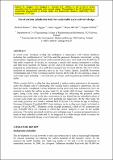Use of carbon calculation tools for sustainable cycle network design

View/
Date
2012Author
Manton, Richard
Duggan, Alan R.
Goggins, Jamie
McCabe, Bryan A.
Clifford, Eoghan
Metadata
Show full item recordUsage
This item's downloads: 401 (view details)
Recommended Citation
Manton, R., Duggan, A.R., Goggins, J., McCabe, B.A., Clifford, E. (2012) Use of carbon calculation tools for sustainable cycle network design 7th Conference on Sustainable Development of Energy, Water and Environment Systems (SDEWES) Ohrid, Macedonia,
Published Version
Abstract
In recent years European cycling has undergone a renaissance with various initiatives
including the establishment of EuroVelo and the proposed European trans-border cycling
infrastructure. Significant advances on this infrastructure have been made with 45,000 km of
bike paths completed. In Ireland, to encourage a modal shift among commuters to cycling,
and help boost facilities for leisure cyclists and cycle tourism, the Irish Government has
proposed the establishment of a 2,000 km National Cycle Network (NCN). The NCN will be
modelled on international networks such as the Vias Verdes (Spain), Landelijk Fietsroutes
(Netherlands) and D-Netz (Germany) and the Sustrans NCN (UK). It will comprise a range of
cycle route types including: (i) on-road, (ii) cycle lanes, and (iii) greenways (traffic-free cycle
trails).
While a modal shift to cycling has clear potential to reduce carbon emissions in the transport
sector the climate cost of constructing new cycling routes, particularly greenways, has not
been previously considered. Carbon emissions during rural cycle lane construction, have the
potential to negate the carbon savings made by the modal shift of many commuters. This
paper, using a case study, describes a methodology for calculating the potential carbon
emissions associated with cycle lane construction. It was found that the embodied carbon of
on-road cycle routes and cycle lanes were generally not significant. On the other hand, the
case study greenway was found to embody 60.4 tCO2e/km. The carbon savings of shifting a
Passenger Kilometre Travelled (PKT) from driving a car to cycling were found, in Ireland, to
average 134 gCO2e/PKT. Therefore, in the example presented, a shift of 102 commuters per
year (224,400 PKT) are required to offset the carbon footprint of one 10 km asphalt
greenway. The metric presented can (i) be used, at design stage to compare proposed routes in
terms of their embodied carbon and (ii) be integrated in a wider design matrix to ensure the
efficient and sustainable design of cycle networks internationally.

